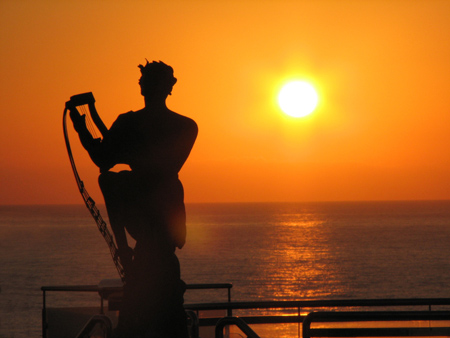Shooting Perfect Sunsets
By Arthur H. Bleich–
You can’t beat a magnificent sunset to make you feel, as Robert Browning put it, “God’s in his heaven– All’s right with the world.”
Frequently though, all’s not right with the pictures you took. Without the salty aroma of the ocean, balmy summer breezes or the sounds of birds singing in the trees, your sunset photos can be a real letdown. While there’s no way to bring back the sensory elements, just a bit of pre-planning can give your pictures that missing zing.
If the sun’s in the picture, your camera’s light meter is going to say: “Oops, too bright, I’d better make the aperture smaller or shutter speed faster (or both) to cut down some of that light.” Result: a perfectly exposed sun (at least as much as possible) and sky colors that could be too dark.
Then again, if there’s no sun in the picture, the metering system might see the colors of the sky as too dark and tell the camera to open the aperture wider or to expose at a slower shutter speed (or both) to get what it thinks should be a good picture. Result: washed out colors that don’t seem to have the richness and saturation you remember.
To get perfect results use your camera’s Exposure Compensation feature to second-guess your camera’s choice of exposure. You can access this feature with a dedicated button on more sophisticated cameras or as a menu item on simpler ones; it overrides the camera’s normal exposure setting to deliberately under or over expose your images. Plus-sign (+) numbers make pictures lighter and minus sign (-) numbers make them darker.
Shoot the first picture at what the camera chooses. Then expose several others using plus or minus numbers (or both) depending on the scene. Among them, the right image will jump out at you– just the way you envisioned it. A few cautions: If the sun’s in the scene, be careful not to go over Plus 1– more than that may be too bright for some camera sensors. And remember to return the exposure value number back to zero when you’ve finished because on most cameras it will stay at its last setting even if the camera is turned off and then on again.
Esthetically, the most dramatic sunsets are either framed by objects in the foreground, have a center of interest further away or both. Many sunset pictures fall flat because there’s no sense of depth created by objects in the foreground, or nothing further away to give the feeling of scale before the eye runs smack into the horizon.
Try for something in the foreground– for example, a tree or a person silhouetted against the colorful sky. (Make sure your flash is “off” for this effect.) More distant objects could be structures (like a lighthouse or a sailboat) or a barn or grazing cattle if you’re shooting a rural sunset.
Finally, to spice up the colors, take your camera off the “Auto” white balance setting and manually set it to “Cloudy” which will add reds and yellows to warm up the colors so they really pop.

A dramatic sunset at sea was shot in the Caribbean by workshop attendee Birget Bienek during a digital photography cruise conducted by the writer of this article.
Original Publication Date: March 28, 2014
Article Last updated: March 28, 2014
Comments are closed.
Categories
About Photographers
Announcements
Back to Basics
Books and Videos
Cards and Calendars
Commentary
Contests
Displaying Images
Editing for Print
Events
Favorite Photo Locations
Featured Software
Free Stuff
Handy Hardware
How-To-Do-It
Imaging
Inks and Papers
Marketing Images
Monitors
Odds and Ends
Photo Gear and Services
Photo History
Photography
Printer Reviews
Printing
Printing Project Ideas
Red River Paper
Red River Paper Pro
RRP Newsletters
RRP Products
Scanners and Scanning
Success on Paper
Techniques
Techniques
Tips and Tricks
Webinars
Words from the Web
Workshops and Exhibits
all
Archives
March, 2024
February, 2024
January, 2024
December, 2023
November, 2023
October, 2023
September, 2023
August, 2023
May, 2023
more archive dates
archive article list







